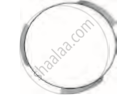Advertisements
Advertisements
प्रश्न
A 4 cm tall object is placed on the principal axis of a convex lens. The distance of the object from the optical centre of the lens is 12 cm and its sharp image is formed at a distance of 24 cm from it on a screen on the other side of the lens. If the object is now moved a little away from the lens, in which way (towards the lens or away from the lens) will he have to move the screen to get a sharp image of the object on it again? How will the magnification of the image be affected?
उत्तर
Given that
Object distance, u = −12 cm
Image distance, v = 24 cm
`1/"f"=1/"v"-1/"u"`
`1/"f"=1/24-1/((-12))`
`1/"f"=1/8`
`therefore"f"=8cm`
The focal length of the lens is 8 cm.
Now if the object is moved away from the lens, the screen has to be moved towards the lens. This is because when we move the object away from the lens, the object distance is increased. Hence, by the lens formula, the image distance decreases.
Magnification is given as
`"m"="v"/"u"`
Because the image distance (v) decreases, the value of magnification also decreases.
APPEARS IN
संबंधित प्रश्न
Give one use each of a concave and a convex mirror.
A ray of light strikes a plane mirror at an angle of 40° to the mirror surface. What will be the angle of reflection?
Complete the following sentence:
All the distances are measured from the .......... of a spherical mirror.
How is a spherical mirror used to diverge a beam of light from a point? Name the type of mirror used.
If a spherical mirror breaks, what type of mirrors are the individual pieces?
Three mirrors are created from a single sphere. Which of the following - pole, centre of curvature, radius of curvature, principal axis - will be common to them and which will not be common?

State the position of object for which the image formed by a concave mirror is of same size.
Define the term Normal.
A ray of light is incident towards a plane mirror at an angle of 30° with the mirror surface. What will be the angle of reflection?
